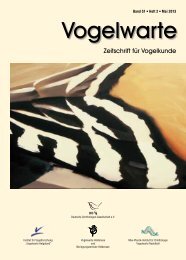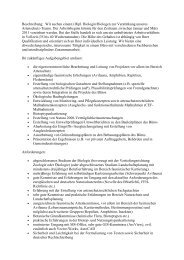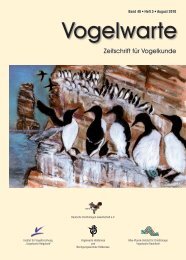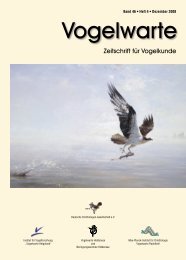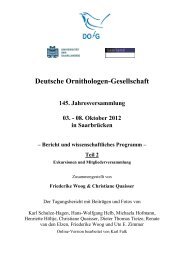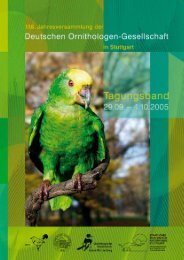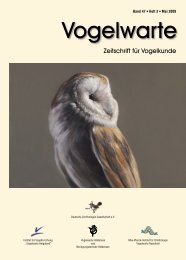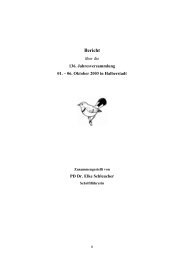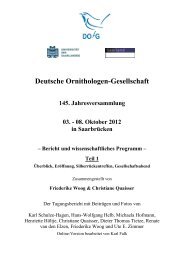Vogelwarte Band 44 - 2006 - DO-G
Vogelwarte Band 44 - 2006 - DO-G
Vogelwarte Band 44 - 2006 - DO-G
Sie wollen auch ein ePaper? Erhöhen Sie die Reichweite Ihrer Titel.
YUMPU macht aus Druck-PDFs automatisch weboptimierte ePaper, die Google liebt.
<strong>Vogelwarte</strong> <strong>44</strong>, <strong>2006</strong>: 209–227<br />
© <strong>DO</strong>-G, IfV, MPG <strong>2006</strong><br />
Phänologie und Bestandsentwicklung der Schlafplatz-Bestände von Möwen<br />
(Laridae) 1989/90-2005/06 am Alfsee (südwestliches Niedersachsen)<br />
Bernd-Olaf Flore<br />
Flore BO <strong>2006</strong>: Phenology and trends of roosting numbers of gulls (Laridae) at Lake Alfsee, southwestern Lower Saxony,<br />
1989/90-2005/06. <strong>Vogelwarte</strong> <strong>44</strong>: 209–227.<br />
Results of long-term counts of gulls at an inland roost on Lake Alfsee, northwestern Germany (52°30´N, 7°59´E), are<br />
presented. Lake Alfsee is a flood detention basin of about 210 ha, the building was completed in 1982. It is located some<br />
100-140 km south of the North Sea coast. Between December 1988 and September <strong>2006</strong> a total of 753 gull counts was<br />
conducted with a mean of 42 counts per year (1989-2005). Usually gulls were counted once per monthly decade throughout<br />
the whole year around sunset. Gulls have never bred at the Alfsee. The most important feeding site of gulls roosting at Lake<br />
Alfsee was a large rubbish dump at Osnabrück-Piesberg, 19 km south. The dump was established in 1976 and closed officially<br />
in May 2005, but food was available until early <strong>2006</strong>.<br />
Black-headed Gulls (Larus ridibundus) occurred all the year round. Higher numbers were found in July-March with peaks<br />
in July/August and in November-March (max. 11,300 ind.). Common Gulls (L. canus) were most numerous between November<br />
and March (max. 6,600 ind.), with peak numbers usually during periods of cold spells (often in January/February).<br />
Herring Gulls (L. argentatus) were found mainly between November and March with peak numbers in December/January<br />
(max. 6,500 ind.). Lesser Black-backed Gulls (L. fuscus) was the scarcest of the four species (max. 270 ind.) with largest<br />
numbers in spring (March-May) and summer (July-August). Winter records of this species were irregular and never involved<br />
more than a few individuals. During prolonged periods of cold temperatures and ice cover the numbers of all species dropped<br />
substantially and a lot of gulls moved away or stayed in Osnabrück. They roosted on roofs of industrial buildings at different<br />
places or at the channel harbour of the city. All species showed pronounced variation in phenologies between years.<br />
Trends in numbers were calculated based on total numbers per years, where years were defined as the period between<br />
early July of one year till late June of the next (1989/90-2005/06). This definition of ”bird years” was used in order to include<br />
only one reproductive period and one winter climate. Furthermore, maximum numbers in winter months (1988/89-2005/06)<br />
or other seasons (e.g. spring or summer, 1989-<strong>2006</strong>) are presented. Totals of Black-headed Gulls showed lowest numbers<br />
in 1996/97, but increased until 2004/05. Low winter maxima in 1995/96 and 1996/97 were mainly caused by prolonged<br />
periods of freezing temperatures. However, summer numbers showed similar trends with a decrease between 1989 and<br />
1997 and an increase after 1997. Numbers of Common Gulls increased during the study period and peaked in 2004/05 and<br />
2005/06. In winter, the monthly maxima increased significantly with lower daily mean temperatures. For Herring Gulls,<br />
the annual totals were considerably higher in the period 1991/92-1994/95 and dropped in 1995/96, caused by a cold winter.<br />
After a reincrease until 1998/99, numbers crashed again. Decreases of numbers in December and January were significant.<br />
Lesser Black-backed Gulls were generally much rarer. Highest annual totals were found in 1993/94 and during 1997/98-<br />
2000/01. After some years with lower numbers, a high total was reached again in 2005/06. For all species within a year, the<br />
maxima of the three winter months or per season differed remarkable each. Generally, gull numbers at inland roosts are<br />
highly dynamic.<br />
The annual phenologies and trends of the gulls on Lake Alfsee are discussed in relation to other studies from northern<br />
Germany and parts of The Netherlands, but long-term studies at roosts are lacking so far. Regarding the origin of gulls<br />
wintering in northern Germany, Black-headed and Common Gulls derive mainly from populations around the Baltic Sea.<br />
The breeding population of the Black-headed Gull especially in the Baltic area is declining, but the situation for Common<br />
Gulls is much more uncertain. At Lake Alfsee Herring Gulls in winter month as well as Lesser Black-backed Gulls in summer<br />
month are likely to belong predominantly to the breeding population of the southern North Sea. The breeding numbers<br />
of both species have especially increased throughout the last three decades of the 20 th century and obviously favoured the<br />
increasing numbers both at Lake Alfsee and in many parts of northern Germany.<br />
Due to a governmental direction every rubbish dump in Germany should have been closed until the mid of 2005. Hence,<br />
the ”good times” for gulls with food richness on rubbish dumps especially during severe weather in winter have become<br />
history. Decreasing numbers at roosts and other resting areas should be expected for the coming years and with a long-term<br />
view, decreasing population levels are very likely, particularly for Herring Gulls.<br />
BOF: Gartlager Weg 54, D-49086 Osnabrück. E-Mail: FloreBeOl@aol.com




